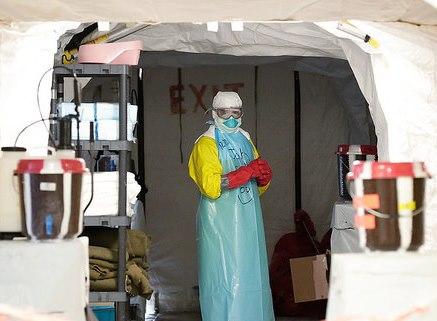An independent expert group called together in the wake of the Ebola crisis to plot out ways to better prepare the world for the next global disease threat unveiled its findings today, among them a $4.5 billion yearly investment for better detection and response tools.
Annual investments of that amount would be a bargain, compared with the estimated $60 billion per year in economic losses in a pandemic, according to the group, which was supported by eight major philanthropic and academic groups. The experts released their findings today at a briefing in New York City and published them on the National Academy of Medicine (NAM) Web site, along with a related overview in today's New England Journal of Medicine.
The report joins others that looked at problems that tripped up the global Ebola response and comes the day before Liberia is slated to be free of the virus again, which would signal that transmission has ended in all three of the West Africa outbreak countries.
The groups that convened and supported the expert commission include the Paul G. Allen Family Foundation, Ford Foundation, Bill & Melinda Gates Foundation, Ming Wai Lau, Gordon and Betty Moore Foundation, Rockefeller Foundation, the United States Agency for International Development, and Wellcome Trust.
Called the Commission on a Global Health Risk Framework for the Future (GHRF), the 17-member group was chaired by Peter Sands, MPA, senior fellow with the Mossavar-Rahmani Center for Business and Government at the Harvard Kennedy School. NAM staff assisted the team with its work, which included four workshops and the input of more than 250 experts, covering four main areas: financing, governance, health systems, and research and development.
Risks and expenditures
Breaking down their $4.5 billion annual preparedness estimate, the experts said $3.4 billion would be earmarked for public health system upgrades for low- and middle-income countries. Another $1 billion would be set aside to speed the development of drugs, vaccines, and other medical products to counter emerging threats.
Sands said in a press release that that world has neglected pandemic preparedness investments. "Pandemics don't respect national boundaries, so we have a common interest in strengthening our defenses against infectious diseases in every part of the world.
"Preventing and preparing for potentially catastrophic pandemics is far more effective—and ultimately, far less expensive—than reacting to them when they occur, which they will."
In their report, the group predicted that at least one pandemic will occur over the next 100 years, and they put a 20% chance on four or more such events occurring in that time span.
Global capabilities can't compensate for health infrastructure gaps in individual countries, the team noted, pointing out that Uganda has shown that health and disease-containment systems can be strengthened, even when resources are scarce.
They suggested that the World Health Organization (WHO) lead an effort to define and set core public health benchmarks by the end of 2016, then establish an independent system to monitor and ensure that countries are making progress toward meeting their benchmarks. Experts said the system would be public, so that countries, the public, and the financial sector could gauge their infectious disease risks. Country participation in the assessment system would come with World Bank support for health system improvements.
In addition, the group sees a bigger leadership role for the WHO to coordinate international response to global disease threats. It recommended that the WHO set up a Center for Health Emergency Preparedness and Response by the end of the year, with oversight from an independent technical board and funding from member states.
Last year other groups recommended that the WHO set up a unified center to coordinate outbreak response. They included the WHO's independent panel led by Dame Barbara Stocking and another effort headed by Peter Piot, MD, PhD, one of the scientists who helped discover the Ebola virus in 1976.
The GHRF commission also sees a leadership role for the WHO in research and development and recommended that it set up an independent Pandemic Product Development Committee to prioritize and coordinate the efforts.
Reactions to today's report
Victor Dzau, MD, NAM president and professor of medicine at Harvard Medical School, said in a statement that one of the report's strengths is the global preparedness cost projections. "Importantly, it boldly assigns dollar figures and timelines to its recommendations. I believe this report is exactly what is needed to drive progress in this critical issue of global health and security."
In a statement of support today posted on the GHRF Web site, Dame Sallie Davies, MD, chief medical officer of the UK Department of Health, said she welcomed the report, especially its emphasis on strengthening local health systems. "I hope that the WHO will build on this report, alongside the other recent reviews, to continue their important reform work that that is already underway," she said.
Larry Summers, an economist who was US treasury secretary in the Clinton administration, introduced the report today at the New York City briefing and lauded its focus in a blog post today. He put the threat of pandemics over the next century on par with that from global climate change.
Summers said he and his colleagues have calculated what the cost would be for a repeat of the 1918 pandemic, which they will publish soon. They project that global cost for such an event would approach $1 trillion a year.
"This underscores the urgency of doing all that can be done to counter pandemic risks," Summers wrote.
See also:
Jan 13 GHRF report
GHRF report portal
Jan 13 NAS press release
Jan 13 N Engl J Med report
Jul 7 CIDRAP News story "WHO independent panel calls out Ebola response flaws"
Nov 19 CIDRAP News story "Panel suggests separate WHO subgroup for outbreaks"
Jan 13 Larry Summers blog post


















